Human Resource Development Report: Training Needs at Sun Court
VerifiedAdded on 2020/07/23
|17
|5498
|48
Report
AI Summary
This report analyzes human resource development (HRD) within the context of Sun Court Ltd., a care home provider. It begins by defining HRD and its importance in improving employee skills and organizational effectiveness. The report then explores various learning styles (pragmatists, activists, theorists, and reflectors) and the significance of the learning curve in assessing employee progress. It delves into training needs at different organizational levels, including management, customer service, and operations. The report also examines the advantages and disadvantages of different training methods, such as performance appraisals and role-playing, and outlines an approach to planning effective training events. Finally, it discusses evaluation techniques, the role of government in training, and the impact of competency development on both public and private sectors, concluding with an assessment of contemporary training initiatives.

Human resource development
Paraphrase This Document
Need a fresh take? Get an instant paraphrase of this document with our AI Paraphraser

Table of Contents
INTRODUCTION...........................................................................................................................1
TASK 1............................................................................................................................................1
1.1 Comparison of learning styles ..............................................................................................1
1.2 Learning curve and its significance.......................................................................................2
1.3 Learning styles and theories in planning a training event ....................................................4
TASK 2............................................................................................................................................5
2.1 Training needs of staff members...........................................................................................5
2.2 Advantages and disadvantages of training methods ............................................................6
2.3 Approach to plan a training event.........................................................................................7
TASK 3............................................................................................................................................9
3.1 Evaluation using suitable techniques....................................................................................9
3.2 Evaluation of a training event............................................................................................10
3.3 Reviewing the success of evaluation techniques................................................................10
TASK 4..........................................................................................................................................11
4.1 Role of government in training and lifelong learning ........................................................11
4.2 Impact of competency development on public and private sectors ...................................12
4.3 Assess contemporary training initiatives ...........................................................................12
CONCLUSION..............................................................................................................................13
REFERENCES .............................................................................................................................14
INTRODUCTION...........................................................................................................................1
TASK 1............................................................................................................................................1
1.1 Comparison of learning styles ..............................................................................................1
1.2 Learning curve and its significance.......................................................................................2
1.3 Learning styles and theories in planning a training event ....................................................4
TASK 2............................................................................................................................................5
2.1 Training needs of staff members...........................................................................................5
2.2 Advantages and disadvantages of training methods ............................................................6
2.3 Approach to plan a training event.........................................................................................7
TASK 3............................................................................................................................................9
3.1 Evaluation using suitable techniques....................................................................................9
3.2 Evaluation of a training event............................................................................................10
3.3 Reviewing the success of evaluation techniques................................................................10
TASK 4..........................................................................................................................................11
4.1 Role of government in training and lifelong learning ........................................................11
4.2 Impact of competency development on public and private sectors ...................................12
4.3 Assess contemporary training initiatives ...........................................................................12
CONCLUSION..............................................................................................................................13
REFERENCES .............................................................................................................................14
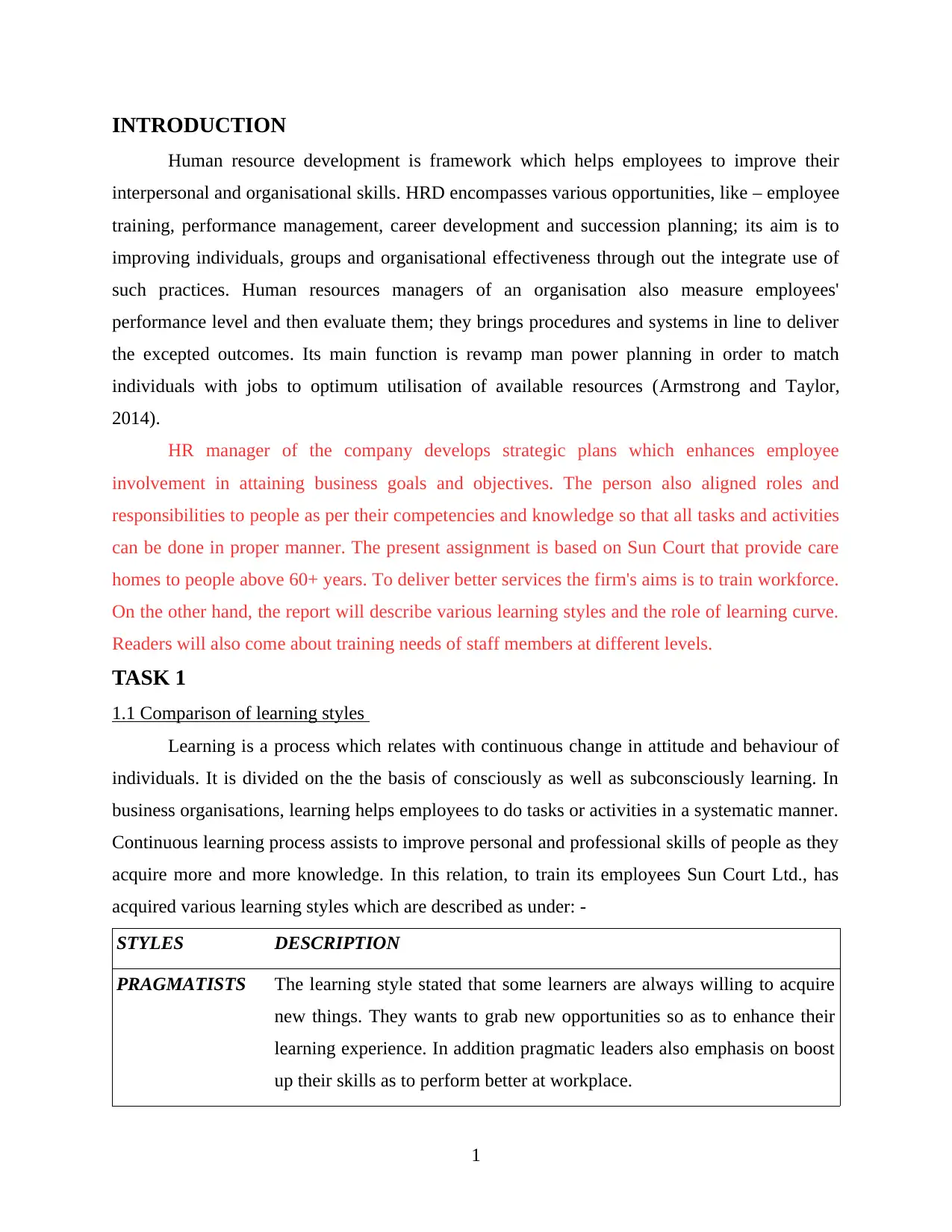
INTRODUCTION
Human resource development is framework which helps employees to improve their
interpersonal and organisational skills. HRD encompasses various opportunities, like – employee
training, performance management, career development and succession planning; its aim is to
improving individuals, groups and organisational effectiveness through out the integrate use of
such practices. Human resources managers of an organisation also measure employees'
performance level and then evaluate them; they brings procedures and systems in line to deliver
the excepted outcomes. Its main function is revamp man power planning in order to match
individuals with jobs to optimum utilisation of available resources (Armstrong and Taylor,
2014).
HR manager of the company develops strategic plans which enhances employee
involvement in attaining business goals and objectives. The person also aligned roles and
responsibilities to people as per their competencies and knowledge so that all tasks and activities
can be done in proper manner. The present assignment is based on Sun Court that provide care
homes to people above 60+ years. To deliver better services the firm's aims is to train workforce.
On the other hand, the report will describe various learning styles and the role of learning curve.
Readers will also come about training needs of staff members at different levels.
TASK 1
1.1 Comparison of learning styles
Learning is a process which relates with continuous change in attitude and behaviour of
individuals. It is divided on the the basis of consciously as well as subconsciously learning. In
business organisations, learning helps employees to do tasks or activities in a systematic manner.
Continuous learning process assists to improve personal and professional skills of people as they
acquire more and more knowledge. In this relation, to train its employees Sun Court Ltd., has
acquired various learning styles which are described as under: -
STYLES DESCRIPTION
PRAGMATISTS The learning style stated that some learners are always willing to acquire
new things. They wants to grab new opportunities so as to enhance their
learning experience. In addition pragmatic leaders also emphasis on boost
up their skills as to perform better at workplace.
1
Human resource development is framework which helps employees to improve their
interpersonal and organisational skills. HRD encompasses various opportunities, like – employee
training, performance management, career development and succession planning; its aim is to
improving individuals, groups and organisational effectiveness through out the integrate use of
such practices. Human resources managers of an organisation also measure employees'
performance level and then evaluate them; they brings procedures and systems in line to deliver
the excepted outcomes. Its main function is revamp man power planning in order to match
individuals with jobs to optimum utilisation of available resources (Armstrong and Taylor,
2014).
HR manager of the company develops strategic plans which enhances employee
involvement in attaining business goals and objectives. The person also aligned roles and
responsibilities to people as per their competencies and knowledge so that all tasks and activities
can be done in proper manner. The present assignment is based on Sun Court that provide care
homes to people above 60+ years. To deliver better services the firm's aims is to train workforce.
On the other hand, the report will describe various learning styles and the role of learning curve.
Readers will also come about training needs of staff members at different levels.
TASK 1
1.1 Comparison of learning styles
Learning is a process which relates with continuous change in attitude and behaviour of
individuals. It is divided on the the basis of consciously as well as subconsciously learning. In
business organisations, learning helps employees to do tasks or activities in a systematic manner.
Continuous learning process assists to improve personal and professional skills of people as they
acquire more and more knowledge. In this relation, to train its employees Sun Court Ltd., has
acquired various learning styles which are described as under: -
STYLES DESCRIPTION
PRAGMATISTS The learning style stated that some learners are always willing to acquire
new things. They wants to grab new opportunities so as to enhance their
learning experience. In addition pragmatic leaders also emphasis on boost
up their skills as to perform better at workplace.
1
⊘ This is a preview!⊘
Do you want full access?
Subscribe today to unlock all pages.

Trusted by 1+ million students worldwide

ACTIVISTS Such learners prefer to learn new things or concepts without any
involvement of other persons. At the time of emergences, these employees
acts a saviour of the company by taking initiative or fast decisions in order
to control the situation. Activists learners become so prompt towards their
work as they are known as they pillar of the company (Avey and et. al.,
2011).
THEORISTS:- These people gives most of their time in thinking, examining and
measuring the data and information which is gathered from various
sources. It helps management to reach at a logical conclusion, as such
learners tries to evaluate each and everything and determine the actual
situation so as to take imperative decisions. Their decisions are not made
by just guesses instead the employees here tries to become perfectionists
as their decisions are made on theories and logics
REFLECTORS:- At last, reflector learners doesn't participate willingly in group activities
within organisations. Basically, they are known as the back bencher of the
company who discover all aspects from behind do not prefer to come in
front. Before making any decision, they thinks a lot (Ployhart and
Moliterno, 2011).
1.2 Learning curve and its significance
Learning curve is used as the tool which aids in measuring the capabilities of staff
members for execution of any working activities in an effective manner. It represents the scale of
progress of employees in order to acquire their competencies and knowledge. Along with this,
learning curve is a graphical representation which states regular improvements in progress of
staff member that is raised as per experience. Human resource managers follow the curve in
order to attain excellence and efficiency within business environment (Bloom and Van Reenen,
2011). In this manner, Sun Court Ltd., sets new and innovative techniques as employees' can
easily face new challenges.
Furthermore, learning curve assists staff members to emphasis on identify their hidden
skills as well as adding value to make successful career path for themselves. In addition, it also
2
involvement of other persons. At the time of emergences, these employees
acts a saviour of the company by taking initiative or fast decisions in order
to control the situation. Activists learners become so prompt towards their
work as they are known as they pillar of the company (Avey and et. al.,
2011).
THEORISTS:- These people gives most of their time in thinking, examining and
measuring the data and information which is gathered from various
sources. It helps management to reach at a logical conclusion, as such
learners tries to evaluate each and everything and determine the actual
situation so as to take imperative decisions. Their decisions are not made
by just guesses instead the employees here tries to become perfectionists
as their decisions are made on theories and logics
REFLECTORS:- At last, reflector learners doesn't participate willingly in group activities
within organisations. Basically, they are known as the back bencher of the
company who discover all aspects from behind do not prefer to come in
front. Before making any decision, they thinks a lot (Ployhart and
Moliterno, 2011).
1.2 Learning curve and its significance
Learning curve is used as the tool which aids in measuring the capabilities of staff
members for execution of any working activities in an effective manner. It represents the scale of
progress of employees in order to acquire their competencies and knowledge. Along with this,
learning curve is a graphical representation which states regular improvements in progress of
staff member that is raised as per experience. Human resource managers follow the curve in
order to attain excellence and efficiency within business environment (Bloom and Van Reenen,
2011). In this manner, Sun Court Ltd., sets new and innovative techniques as employees' can
easily face new challenges.
Furthermore, learning curve assists staff members to emphasis on identify their hidden
skills as well as adding value to make successful career path for themselves. In addition, it also
2
Paraphrase This Document
Need a fresh take? Get an instant paraphrase of this document with our AI Paraphraser
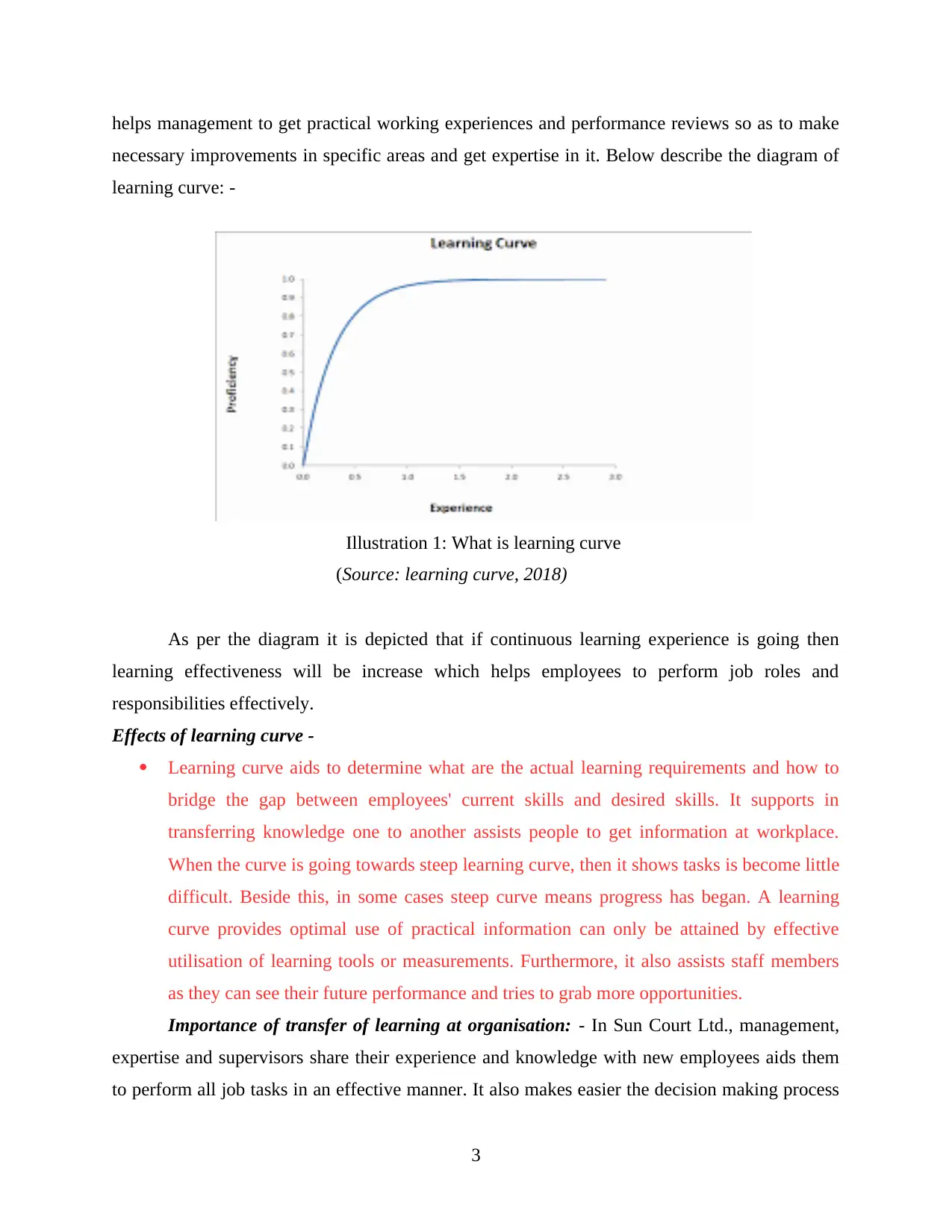
helps management to get practical working experiences and performance reviews so as to make
necessary improvements in specific areas and get expertise in it. Below describe the diagram of
learning curve: -
(Source: learning curve, 2018)
As per the diagram it is depicted that if continuous learning experience is going then
learning effectiveness will be increase which helps employees to perform job roles and
responsibilities effectively.
Effects of learning curve -
Learning curve aids to determine what are the actual learning requirements and how to
bridge the gap between employees' current skills and desired skills. It supports in
transferring knowledge one to another assists people to get information at workplace.
When the curve is going towards steep learning curve, then it shows tasks is become little
difficult. Beside this, in some cases steep curve means progress has began. A learning
curve provides optimal use of practical information can only be attained by effective
utilisation of learning tools or measurements. Furthermore, it also assists staff members
as they can see their future performance and tries to grab more opportunities.
Importance of transfer of learning at organisation: - In Sun Court Ltd., management,
expertise and supervisors share their experience and knowledge with new employees aids them
to perform all job tasks in an effective manner. It also makes easier the decision making process
3
Illustration 1: What is learning curve
necessary improvements in specific areas and get expertise in it. Below describe the diagram of
learning curve: -
(Source: learning curve, 2018)
As per the diagram it is depicted that if continuous learning experience is going then
learning effectiveness will be increase which helps employees to perform job roles and
responsibilities effectively.
Effects of learning curve -
Learning curve aids to determine what are the actual learning requirements and how to
bridge the gap between employees' current skills and desired skills. It supports in
transferring knowledge one to another assists people to get information at workplace.
When the curve is going towards steep learning curve, then it shows tasks is become little
difficult. Beside this, in some cases steep curve means progress has began. A learning
curve provides optimal use of practical information can only be attained by effective
utilisation of learning tools or measurements. Furthermore, it also assists staff members
as they can see their future performance and tries to grab more opportunities.
Importance of transfer of learning at organisation: - In Sun Court Ltd., management,
expertise and supervisors share their experience and knowledge with new employees aids them
to perform all job tasks in an effective manner. It also makes easier the decision making process
3
Illustration 1: What is learning curve

of the firm (Boxall and Purcell, 2011). Forwarding data through off the job training methods also
helps people to get better knowledge for completion of specific task.
1.3 Learning styles and theories in planning a training event
Training process aids in boost up employees' skills, while planning an effective training
event human resource manager has to determine the various learning styles that would assists in
it. Although, learning styles find out the workplace issues and problems. There is defined various
learning styles which are stated as under: -
Visual learning: This learning style uses of images, pictures, pie charts, graphs etc.
Social learning: It gives preference to learning in a group or team.
Solitary learning: In that, individuals prefer to learn alone, they thinks they will gain
much better knowledge.
Aural learning: It uses music or sounds at the time of learning.
Verbal learning: It prefer the use of words in form of speech as well as written.
These learning theories states a theoretical framework so as to build up individual's skills
and knowledge level. But which style will be used, it totally relies on the staff members' interest
and their capabilities how fast they can acquire changes. Thus, before conducting training events
learning styles have to measures properly and interpreted on the basis of organisational goals and
objectives (Bratton and Gold, 2012). Learning theories or styles cater: -
Efficient learning ways
Sensible knowledge
Methods of designing HR as well as training events
Learning events consists with implementation of learning styles in a systematic way; it is
prepared to attain organisational goals. It enhances the capabilities of staff members, which
result higher output level of the firm. Sun Court Ltd., is using various learning styles for
implementing training events. The main objective of execution of learning styles is to gain better
outcomes and higher productivity. Along with this, to prepare a learning event workers have to
be active and act willingly, management also have to provide them open and freely environment
in which all can share their ideas and thoughts with each other.
4
helps people to get better knowledge for completion of specific task.
1.3 Learning styles and theories in planning a training event
Training process aids in boost up employees' skills, while planning an effective training
event human resource manager has to determine the various learning styles that would assists in
it. Although, learning styles find out the workplace issues and problems. There is defined various
learning styles which are stated as under: -
Visual learning: This learning style uses of images, pictures, pie charts, graphs etc.
Social learning: It gives preference to learning in a group or team.
Solitary learning: In that, individuals prefer to learn alone, they thinks they will gain
much better knowledge.
Aural learning: It uses music or sounds at the time of learning.
Verbal learning: It prefer the use of words in form of speech as well as written.
These learning theories states a theoretical framework so as to build up individual's skills
and knowledge level. But which style will be used, it totally relies on the staff members' interest
and their capabilities how fast they can acquire changes. Thus, before conducting training events
learning styles have to measures properly and interpreted on the basis of organisational goals and
objectives (Bratton and Gold, 2012). Learning theories or styles cater: -
Efficient learning ways
Sensible knowledge
Methods of designing HR as well as training events
Learning events consists with implementation of learning styles in a systematic way; it is
prepared to attain organisational goals. It enhances the capabilities of staff members, which
result higher output level of the firm. Sun Court Ltd., is using various learning styles for
implementing training events. The main objective of execution of learning styles is to gain better
outcomes and higher productivity. Along with this, to prepare a learning event workers have to
be active and act willingly, management also have to provide them open and freely environment
in which all can share their ideas and thoughts with each other.
4
⊘ This is a preview!⊘
Do you want full access?
Subscribe today to unlock all pages.

Trusted by 1+ million students worldwide
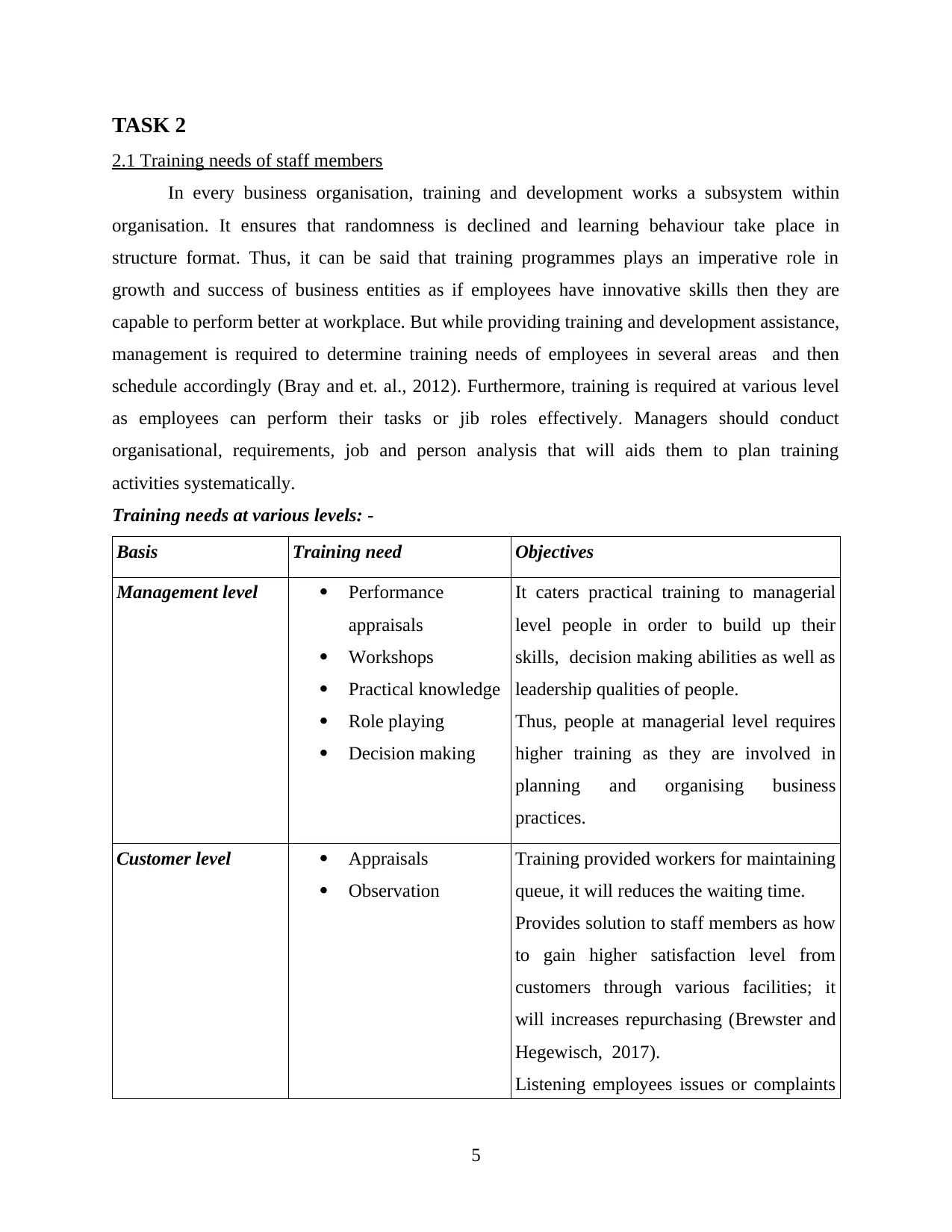
TASK 2
2.1 Training needs of staff members
In every business organisation, training and development works a subsystem within
organisation. It ensures that randomness is declined and learning behaviour take place in
structure format. Thus, it can be said that training programmes plays an imperative role in
growth and success of business entities as if employees have innovative skills then they are
capable to perform better at workplace. But while providing training and development assistance,
management is required to determine training needs of employees in several areas and then
schedule accordingly (Bray and et. al., 2012). Furthermore, training is required at various level
as employees can perform their tasks or jib roles effectively. Managers should conduct
organisational, requirements, job and person analysis that will aids them to plan training
activities systematically.
Training needs at various levels: -
Basis Training need Objectives
Management level Performance
appraisals
Workshops
Practical knowledge
Role playing
Decision making
It caters practical training to managerial
level people in order to build up their
skills, decision making abilities as well as
leadership qualities of people.
Thus, people at managerial level requires
higher training as they are involved in
planning and organising business
practices.
Customer level Appraisals
Observation
Training provided workers for maintaining
queue, it will reduces the waiting time.
Provides solution to staff members as how
to gain higher satisfaction level from
customers through various facilities; it
will increases repurchasing (Brewster and
Hegewisch, 2017).
Listening employees issues or complaints
5
2.1 Training needs of staff members
In every business organisation, training and development works a subsystem within
organisation. It ensures that randomness is declined and learning behaviour take place in
structure format. Thus, it can be said that training programmes plays an imperative role in
growth and success of business entities as if employees have innovative skills then they are
capable to perform better at workplace. But while providing training and development assistance,
management is required to determine training needs of employees in several areas and then
schedule accordingly (Bray and et. al., 2012). Furthermore, training is required at various level
as employees can perform their tasks or jib roles effectively. Managers should conduct
organisational, requirements, job and person analysis that will aids them to plan training
activities systematically.
Training needs at various levels: -
Basis Training need Objectives
Management level Performance
appraisals
Workshops
Practical knowledge
Role playing
Decision making
It caters practical training to managerial
level people in order to build up their
skills, decision making abilities as well as
leadership qualities of people.
Thus, people at managerial level requires
higher training as they are involved in
planning and organising business
practices.
Customer level Appraisals
Observation
Training provided workers for maintaining
queue, it will reduces the waiting time.
Provides solution to staff members as how
to gain higher satisfaction level from
customers through various facilities; it
will increases repurchasing (Brewster and
Hegewisch, 2017).
Listening employees issues or complaints
5
Paraphrase This Document
Need a fresh take? Get an instant paraphrase of this document with our AI Paraphraser
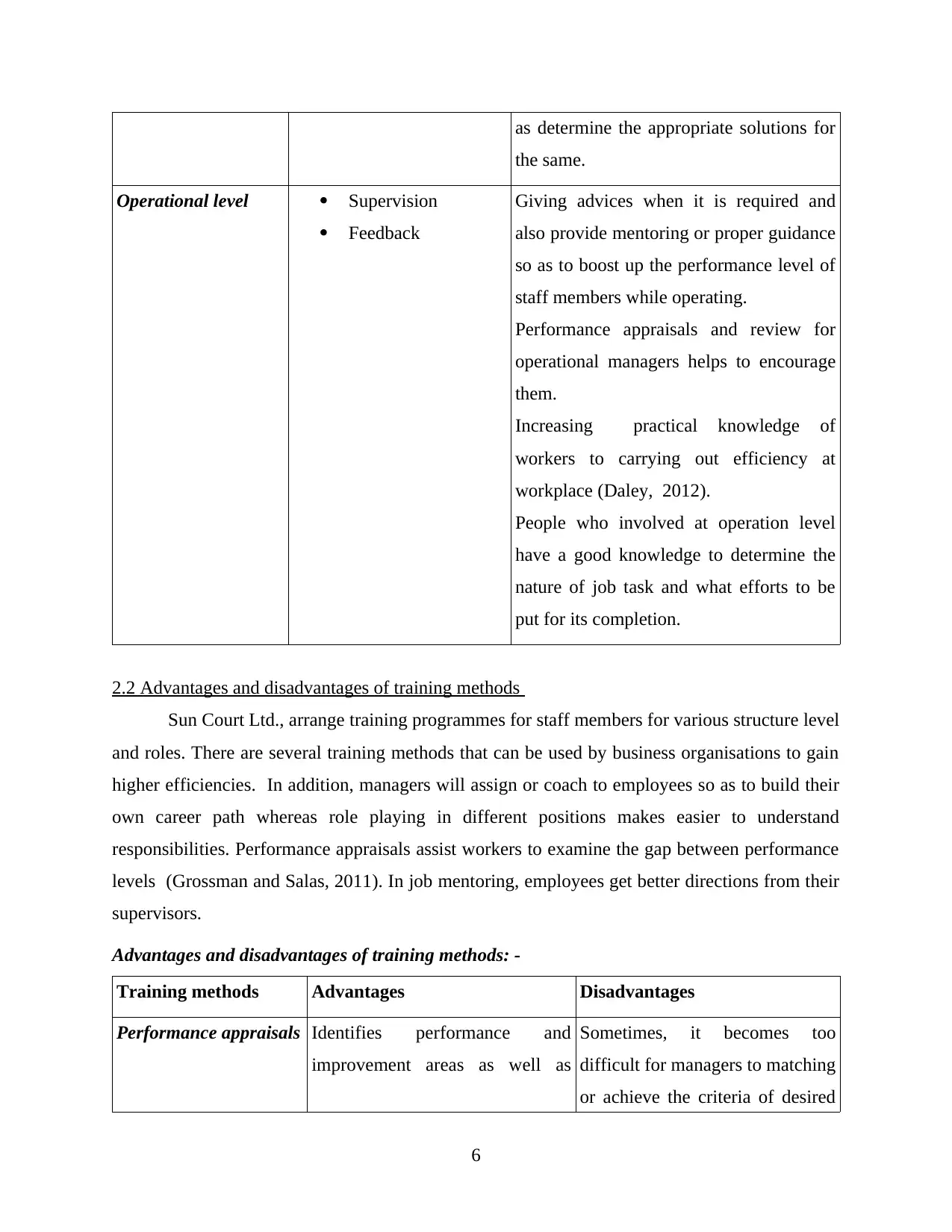
as determine the appropriate solutions for
the same.
Operational level Supervision
Feedback
Giving advices when it is required and
also provide mentoring or proper guidance
so as to boost up the performance level of
staff members while operating.
Performance appraisals and review for
operational managers helps to encourage
them.
Increasing practical knowledge of
workers to carrying out efficiency at
workplace (Daley, 2012).
People who involved at operation level
have a good knowledge to determine the
nature of job task and what efforts to be
put for its completion.
2.2 Advantages and disadvantages of training methods
Sun Court Ltd., arrange training programmes for staff members for various structure level
and roles. There are several training methods that can be used by business organisations to gain
higher efficiencies. In addition, managers will assign or coach to employees so as to build their
own career path whereas role playing in different positions makes easier to understand
responsibilities. Performance appraisals assist workers to examine the gap between performance
levels (Grossman and Salas, 2011). In job mentoring, employees get better directions from their
supervisors.
Advantages and disadvantages of training methods: -
Training methods Advantages Disadvantages
Performance appraisals Identifies performance and
improvement areas as well as
Sometimes, it becomes too
difficult for managers to matching
or achieve the criteria of desired
6
the same.
Operational level Supervision
Feedback
Giving advices when it is required and
also provide mentoring or proper guidance
so as to boost up the performance level of
staff members while operating.
Performance appraisals and review for
operational managers helps to encourage
them.
Increasing practical knowledge of
workers to carrying out efficiency at
workplace (Daley, 2012).
People who involved at operation level
have a good knowledge to determine the
nature of job task and what efforts to be
put for its completion.
2.2 Advantages and disadvantages of training methods
Sun Court Ltd., arrange training programmes for staff members for various structure level
and roles. There are several training methods that can be used by business organisations to gain
higher efficiencies. In addition, managers will assign or coach to employees so as to build their
own career path whereas role playing in different positions makes easier to understand
responsibilities. Performance appraisals assist workers to examine the gap between performance
levels (Grossman and Salas, 2011). In job mentoring, employees get better directions from their
supervisors.
Advantages and disadvantages of training methods: -
Training methods Advantages Disadvantages
Performance appraisals Identifies performance and
improvement areas as well as
Sometimes, it becomes too
difficult for managers to matching
or achieve the criteria of desired
6
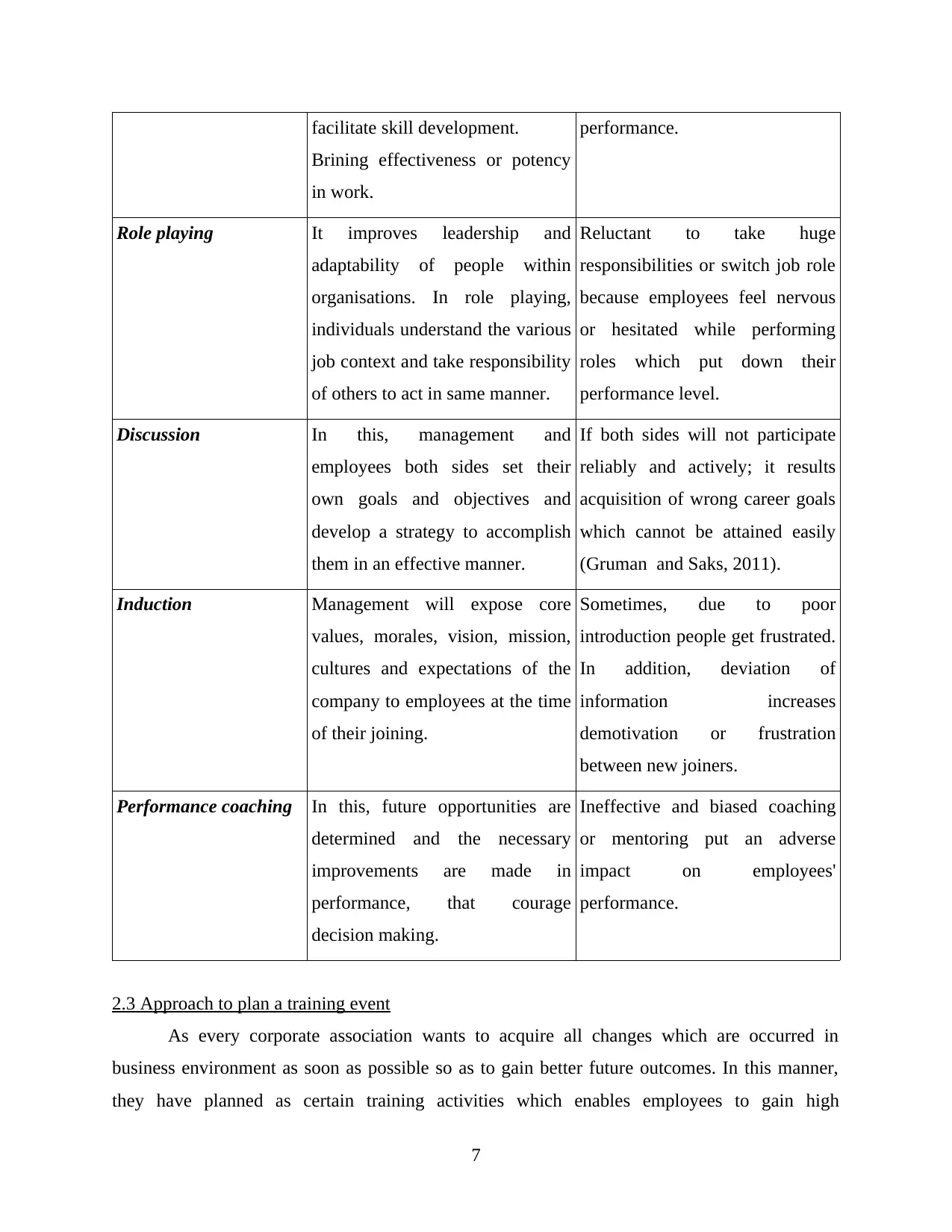
facilitate skill development.
Brining effectiveness or potency
in work.
performance.
Role playing It improves leadership and
adaptability of people within
organisations. In role playing,
individuals understand the various
job context and take responsibility
of others to act in same manner.
Reluctant to take huge
responsibilities or switch job role
because employees feel nervous
or hesitated while performing
roles which put down their
performance level.
Discussion In this, management and
employees both sides set their
own goals and objectives and
develop a strategy to accomplish
them in an effective manner.
If both sides will not participate
reliably and actively; it results
acquisition of wrong career goals
which cannot be attained easily
(Gruman and Saks, 2011).
Induction Management will expose core
values, morales, vision, mission,
cultures and expectations of the
company to employees at the time
of their joining.
Sometimes, due to poor
introduction people get frustrated.
In addition, deviation of
information increases
demotivation or frustration
between new joiners.
Performance coaching In this, future opportunities are
determined and the necessary
improvements are made in
performance, that courage
decision making.
Ineffective and biased coaching
or mentoring put an adverse
impact on employees'
performance.
2.3 Approach to plan a training event
As every corporate association wants to acquire all changes which are occurred in
business environment as soon as possible so as to gain better future outcomes. In this manner,
they have planned as certain training activities which enables employees to gain high
7
Brining effectiveness or potency
in work.
performance.
Role playing It improves leadership and
adaptability of people within
organisations. In role playing,
individuals understand the various
job context and take responsibility
of others to act in same manner.
Reluctant to take huge
responsibilities or switch job role
because employees feel nervous
or hesitated while performing
roles which put down their
performance level.
Discussion In this, management and
employees both sides set their
own goals and objectives and
develop a strategy to accomplish
them in an effective manner.
If both sides will not participate
reliably and actively; it results
acquisition of wrong career goals
which cannot be attained easily
(Gruman and Saks, 2011).
Induction Management will expose core
values, morales, vision, mission,
cultures and expectations of the
company to employees at the time
of their joining.
Sometimes, due to poor
introduction people get frustrated.
In addition, deviation of
information increases
demotivation or frustration
between new joiners.
Performance coaching In this, future opportunities are
determined and the necessary
improvements are made in
performance, that courage
decision making.
Ineffective and biased coaching
or mentoring put an adverse
impact on employees'
performance.
2.3 Approach to plan a training event
As every corporate association wants to acquire all changes which are occurred in
business environment as soon as possible so as to gain better future outcomes. In this manner,
they have planned as certain training activities which enables employees to gain high
7
⊘ This is a preview!⊘
Do you want full access?
Subscribe today to unlock all pages.

Trusted by 1+ million students worldwide
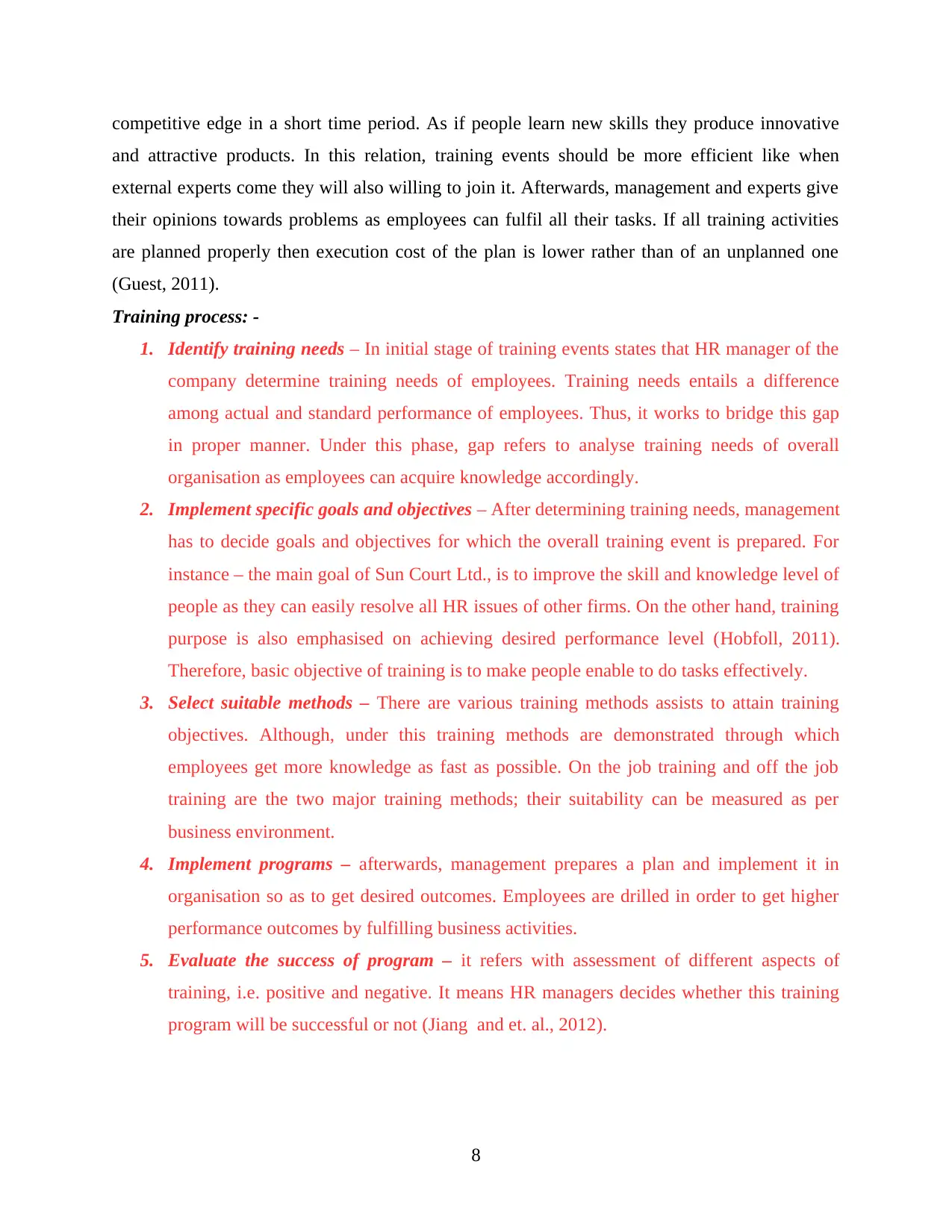
competitive edge in a short time period. As if people learn new skills they produce innovative
and attractive products. In this relation, training events should be more efficient like when
external experts come they will also willing to join it. Afterwards, management and experts give
their opinions towards problems as employees can fulfil all their tasks. If all training activities
are planned properly then execution cost of the plan is lower rather than of an unplanned one
(Guest, 2011).
Training process: -
1. Identify training needs – In initial stage of training events states that HR manager of the
company determine training needs of employees. Training needs entails a difference
among actual and standard performance of employees. Thus, it works to bridge this gap
in proper manner. Under this phase, gap refers to analyse training needs of overall
organisation as employees can acquire knowledge accordingly.
2. Implement specific goals and objectives – After determining training needs, management
has to decide goals and objectives for which the overall training event is prepared. For
instance – the main goal of Sun Court Ltd., is to improve the skill and knowledge level of
people as they can easily resolve all HR issues of other firms. On the other hand, training
purpose is also emphasised on achieving desired performance level (Hobfoll, 2011).
Therefore, basic objective of training is to make people enable to do tasks effectively.
3. Select suitable methods – There are various training methods assists to attain training
objectives. Although, under this training methods are demonstrated through which
employees get more knowledge as fast as possible. On the job training and off the job
training are the two major training methods; their suitability can be measured as per
business environment.
4. Implement programs – afterwards, management prepares a plan and implement it in
organisation so as to get desired outcomes. Employees are drilled in order to get higher
performance outcomes by fulfilling business activities.
5. Evaluate the success of program – it refers with assessment of different aspects of
training, i.e. positive and negative. It means HR managers decides whether this training
program will be successful or not (Jiang and et. al., 2012).
8
and attractive products. In this relation, training events should be more efficient like when
external experts come they will also willing to join it. Afterwards, management and experts give
their opinions towards problems as employees can fulfil all their tasks. If all training activities
are planned properly then execution cost of the plan is lower rather than of an unplanned one
(Guest, 2011).
Training process: -
1. Identify training needs – In initial stage of training events states that HR manager of the
company determine training needs of employees. Training needs entails a difference
among actual and standard performance of employees. Thus, it works to bridge this gap
in proper manner. Under this phase, gap refers to analyse training needs of overall
organisation as employees can acquire knowledge accordingly.
2. Implement specific goals and objectives – After determining training needs, management
has to decide goals and objectives for which the overall training event is prepared. For
instance – the main goal of Sun Court Ltd., is to improve the skill and knowledge level of
people as they can easily resolve all HR issues of other firms. On the other hand, training
purpose is also emphasised on achieving desired performance level (Hobfoll, 2011).
Therefore, basic objective of training is to make people enable to do tasks effectively.
3. Select suitable methods – There are various training methods assists to attain training
objectives. Although, under this training methods are demonstrated through which
employees get more knowledge as fast as possible. On the job training and off the job
training are the two major training methods; their suitability can be measured as per
business environment.
4. Implement programs – afterwards, management prepares a plan and implement it in
organisation so as to get desired outcomes. Employees are drilled in order to get higher
performance outcomes by fulfilling business activities.
5. Evaluate the success of program – it refers with assessment of different aspects of
training, i.e. positive and negative. It means HR managers decides whether this training
program will be successful or not (Jiang and et. al., 2012).
8
Paraphrase This Document
Need a fresh take? Get an instant paraphrase of this document with our AI Paraphraser
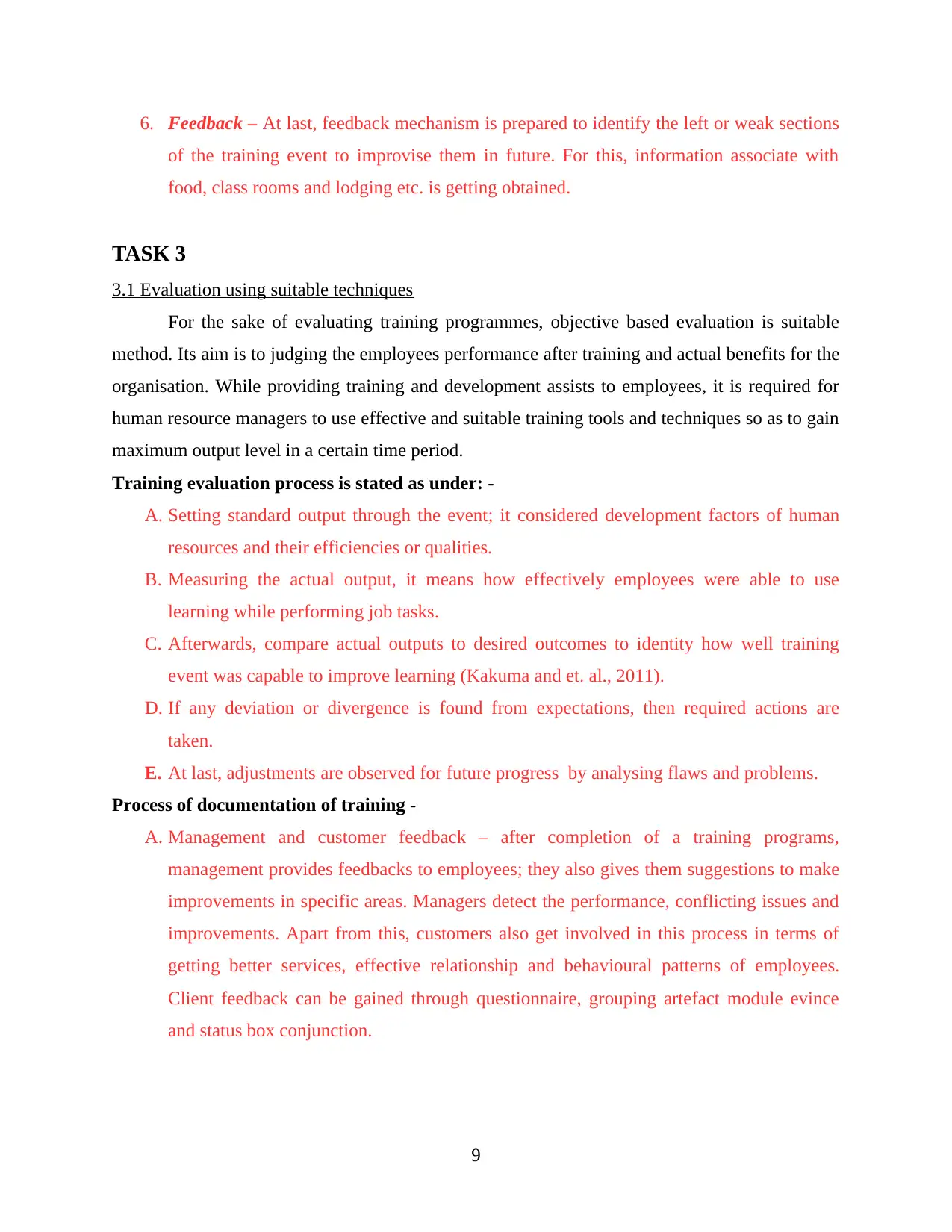
6. Feedback – At last, feedback mechanism is prepared to identify the left or weak sections
of the training event to improvise them in future. For this, information associate with
food, class rooms and lodging etc. is getting obtained.
TASK 3
3.1 Evaluation using suitable techniques
For the sake of evaluating training programmes, objective based evaluation is suitable
method. Its aim is to judging the employees performance after training and actual benefits for the
organisation. While providing training and development assists to employees, it is required for
human resource managers to use effective and suitable training tools and techniques so as to gain
maximum output level in a certain time period.
Training evaluation process is stated as under: -
A. Setting standard output through the event; it considered development factors of human
resources and their efficiencies or qualities.
B. Measuring the actual output, it means how effectively employees were able to use
learning while performing job tasks.
C. Afterwards, compare actual outputs to desired outcomes to identity how well training
event was capable to improve learning (Kakuma and et. al., 2011).
D. If any deviation or divergence is found from expectations, then required actions are
taken.
E. At last, adjustments are observed for future progress by analysing flaws and problems.
Process of documentation of training -
A. Management and customer feedback – after completion of a training programs,
management provides feedbacks to employees; they also gives them suggestions to make
improvements in specific areas. Managers detect the performance, conflicting issues and
improvements. Apart from this, customers also get involved in this process in terms of
getting better services, effective relationship and behavioural patterns of employees.
Client feedback can be gained through questionnaire, grouping artefact module evince
and status box conjunction.
9
of the training event to improvise them in future. For this, information associate with
food, class rooms and lodging etc. is getting obtained.
TASK 3
3.1 Evaluation using suitable techniques
For the sake of evaluating training programmes, objective based evaluation is suitable
method. Its aim is to judging the employees performance after training and actual benefits for the
organisation. While providing training and development assists to employees, it is required for
human resource managers to use effective and suitable training tools and techniques so as to gain
maximum output level in a certain time period.
Training evaluation process is stated as under: -
A. Setting standard output through the event; it considered development factors of human
resources and their efficiencies or qualities.
B. Measuring the actual output, it means how effectively employees were able to use
learning while performing job tasks.
C. Afterwards, compare actual outputs to desired outcomes to identity how well training
event was capable to improve learning (Kakuma and et. al., 2011).
D. If any deviation or divergence is found from expectations, then required actions are
taken.
E. At last, adjustments are observed for future progress by analysing flaws and problems.
Process of documentation of training -
A. Management and customer feedback – after completion of a training programs,
management provides feedbacks to employees; they also gives them suggestions to make
improvements in specific areas. Managers detect the performance, conflicting issues and
improvements. Apart from this, customers also get involved in this process in terms of
getting better services, effective relationship and behavioural patterns of employees.
Client feedback can be gained through questionnaire, grouping artefact module evince
and status box conjunction.
9
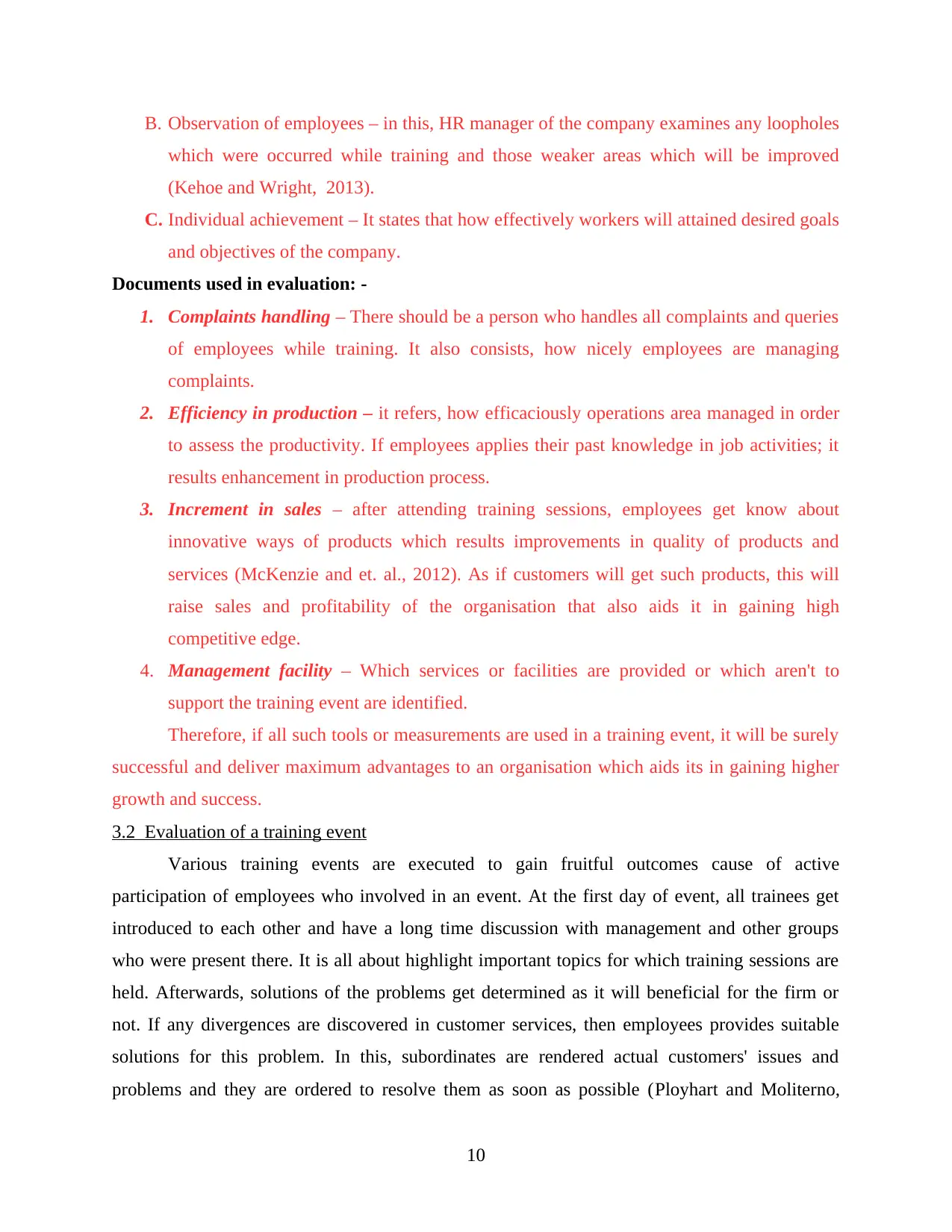
B. Observation of employees – in this, HR manager of the company examines any loopholes
which were occurred while training and those weaker areas which will be improved
(Kehoe and Wright, 2013).
C. Individual achievement – It states that how effectively workers will attained desired goals
and objectives of the company.
Documents used in evaluation: -
1. Complaints handling – There should be a person who handles all complaints and queries
of employees while training. It also consists, how nicely employees are managing
complaints.
2. Efficiency in production – it refers, how efficaciously operations area managed in order
to assess the productivity. If employees applies their past knowledge in job activities; it
results enhancement in production process.
3. Increment in sales – after attending training sessions, employees get know about
innovative ways of products which results improvements in quality of products and
services (McKenzie and et. al., 2012). As if customers will get such products, this will
raise sales and profitability of the organisation that also aids it in gaining high
competitive edge.
4. Management facility – Which services or facilities are provided or which aren't to
support the training event are identified.
Therefore, if all such tools or measurements are used in a training event, it will be surely
successful and deliver maximum advantages to an organisation which aids its in gaining higher
growth and success.
3.2 Evaluation of a training event
Various training events are executed to gain fruitful outcomes cause of active
participation of employees who involved in an event. At the first day of event, all trainees get
introduced to each other and have a long time discussion with management and other groups
who were present there. It is all about highlight important topics for which training sessions are
held. Afterwards, solutions of the problems get determined as it will beneficial for the firm or
not. If any divergences are discovered in customer services, then employees provides suitable
solutions for this problem. In this, subordinates are rendered actual customers' issues and
problems and they are ordered to resolve them as soon as possible (Ployhart and Moliterno,
10
which were occurred while training and those weaker areas which will be improved
(Kehoe and Wright, 2013).
C. Individual achievement – It states that how effectively workers will attained desired goals
and objectives of the company.
Documents used in evaluation: -
1. Complaints handling – There should be a person who handles all complaints and queries
of employees while training. It also consists, how nicely employees are managing
complaints.
2. Efficiency in production – it refers, how efficaciously operations area managed in order
to assess the productivity. If employees applies their past knowledge in job activities; it
results enhancement in production process.
3. Increment in sales – after attending training sessions, employees get know about
innovative ways of products which results improvements in quality of products and
services (McKenzie and et. al., 2012). As if customers will get such products, this will
raise sales and profitability of the organisation that also aids it in gaining high
competitive edge.
4. Management facility – Which services or facilities are provided or which aren't to
support the training event are identified.
Therefore, if all such tools or measurements are used in a training event, it will be surely
successful and deliver maximum advantages to an organisation which aids its in gaining higher
growth and success.
3.2 Evaluation of a training event
Various training events are executed to gain fruitful outcomes cause of active
participation of employees who involved in an event. At the first day of event, all trainees get
introduced to each other and have a long time discussion with management and other groups
who were present there. It is all about highlight important topics for which training sessions are
held. Afterwards, solutions of the problems get determined as it will beneficial for the firm or
not. If any divergences are discovered in customer services, then employees provides suitable
solutions for this problem. In this, subordinates are rendered actual customers' issues and
problems and they are ordered to resolve them as soon as possible (Ployhart and Moliterno,
10
⊘ This is a preview!⊘
Do you want full access?
Subscribe today to unlock all pages.

Trusted by 1+ million students worldwide
1 out of 17
Related Documents
Your All-in-One AI-Powered Toolkit for Academic Success.
+13062052269
info@desklib.com
Available 24*7 on WhatsApp / Email
![[object Object]](/_next/static/media/star-bottom.7253800d.svg)
Unlock your academic potential
Copyright © 2020–2025 A2Z Services. All Rights Reserved. Developed and managed by ZUCOL.





